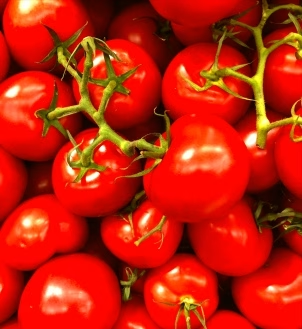Every year on the last Wednesday of August, the Spanish town of Buñol celebrates the passion of summer with red tomatoes. Spain’s Tomato Festival has become an internationally renowned event, attracting 20,000 to 30,000 visitors from around the world to participate in the tomato-throwing event and experience the allure of red.
Over 400 molecules contribute to the smell of “tomato”
There are only five flavors, but the number of odors is vastly greater! Research has found that it takes over 400 volatile odors to create the aroma of tomato. If you smell these molecules individually, you wouldn’t immediately recognize their connection to tomatoes, because the molecular groups that identify tomato aroma are at least 15 or more.
Unlike cinnamon, which has a volatile compound called cinnaminic aldehyde that instantly makes you say, “Ah! Cinnamon!” Eugenol represents cloves, while diacetyl provides a rich, creamy flavor. Let me be frank: tomatoes are truly complex creatures.
Kagome Searched the World, Frantically Collecting Over 7,000 Tomato Seeds
The complexity of tomato seeds has spurred the tomato sauce brand Kagome to pursue delicious tomatoes, traversing the globe. As tomatoes have traveled from their native Peru to various locations around the world, various improved varieties have emerged, tailored to the environment, uses, and preferences.
Kagome has devoted this entire history to researching, continuously collecting every tomato seed along the way, aiming to find the most delicious. This has led to the accumulation of a library of 7,500 varieties. That’s right, over 7,000 varieties.
Vegetarians, Beware: Is Tomato Sauce a Meat?
Vegetarians who avoid onions, garlic, and spices should exercise caution when choosing tomato sauce to avoid potential pitfalls.
Most commercially available condiments, such as black vinegar, curry, and ketchup, contain onions, garlic, onions, leeks, or other spices to enhance their flavor. Vegetarians who avoid spices should be mindful of carefully checking the ingredient list before purchasing.
Sautéed tomatoes are actually healthier than raw.
Although minerals and water-soluble vitamins in vegetables are easily lost in water or destroyed by heat, the nutrients in some vegetables are actually more readily absorbed and utilized after sautéing.
Carotenoid-rich yellow vegetables, such as carrots and tomatoes, are often eaten raw in the West. However, carotenoids are converted into vitamin A in the body, an oil-soluble vitamin that needs to form liposomes with fat and bile salts in the small intestine to enter the human system. Therefore, sautéed tomatoes are actually better for eating raw.
Tomatoes and basil are not only delicious, but also full of scientific logic!
Tomatoes and basil are often paired together. Not only is their flavor perfect, but there’s also nutritional evidence to support this combination!
Basil is rich in beta-carotene, potassium, and calcium. When cooked with tomatoes, which have similar properties, it can enhance the antioxidant power of lycopene. Besides being rich in beta-carotene, basil’s essential oils, such as linalool, camphor, and eugenol, are also known for their appetite-boosting, antibacterial, digestive, and calming properties.
What are the nutritional differences between red, yellow, and green cherry tomatoes?
Red, green, and yellow cherry tomatoes contain a lot of dietary fiber and vitamins, but their nutrient profiles vary.
Red cherry tomatoes have the highest levels of lycopene and beta-carotene, with lycopene’s antioxidant power 100 times that of vitamin E. While yellow cherry tomatoes lack lycopene, they contain over twice as much vitamin A and folate as red tomatoes.
Can drinking tomato juice help with belly fat?
A 2015 study published in the American Journal of Nutrition found that young women who drank one glass (280ml) of pure tomato juice for 56 consecutive days not only experienced a reduction in waist circumference but also lowered their blood cholesterol and lipid levels.
Researchers speculate that this may be due to lycopene, which not only boosts metabolism but also increases adiponectin secretion by 25%, playing a physiological role in combating obesity and the three highs.
The researchers also added that tomatoes are low-GI fruits, naturally helping to control appetite and making them a great snack between meals.
How to preserve the delicious flavor of tomatoes: Never refrigerate them.
How should you store tomatoes after you buy them? Throw them in the refrigerator? But have you ever noticed that the aroma and flavor of tomatoes diminish significantly after being refrigerated for a few days?
This question has piqued the curiosity of scientists! Harry J. Klee, a professor in the Department of Horticultural Sciences at the University of Florida in Gainesville, who specializes in flavor analysis of fruits and vegetables, discovered that tomatoes can be refrigerated for one to three days at temperatures below 5°C, but they begin to lose some of their aroma after about seven days.
This is because refrigeration reduces the transcriptional activity of tomato ripening genes, delaying ripening and reducing aroma. Only when the tomatoes are allowed to warm up at room temperature does the activity slightly recover. Therefore, the key to maintaining the delicious flavor of tomatoes is to buy a moderate amount and eat them immediately; don’t keep them in the refrigerator for too long.
Tomatoes are so delicious because they are rich in MSG
The saying that MSG causes a particularly dry mouth and tongue originated in 1968 when a doctor, after dining at a Chinese restaurant, shared his speculation and analysis (not formal research) about MSG with a medical journal editor. The report was subsequently exposed in the media and caused a sensation, leading to the labeling of MSG that remains unexplained.
But consider this: a 70-kilogram adult consumes 50 grams of protein daily. Of those 50 grams, 15 grams are made up of glutamate. Umami is truly ubiquitous.
It’s found naturally in a variety of foods, such as tomatoes, cheese, milk, and breast milk. Naturally fermented foods like soy sauce, bonito flakes, and oysters are also rich in this glutamate (the ingredient in MSG). Therefore, it’s hard to imagine what health problems consuming an extra 0.5 to 1 gram of MSG could cause.
Tomatoes are so umami-rich because they’re rich in glutamate. Furthermore, they contain adenylate and guanylate, flavor enhancers commonly found in instant noodles and potato chips, which intensify the umami sensation.
Ingredients like mackerel also contain a significant amount of flavor enhancers. So, when a can of tomato and mackerel is added to a simple bowl of pasta, the synergistic effect transforms the dish into an umami powerhouse.
The rich umami flavor of tomato juice can also enhance cocktails, especially those made with less pronounced alcohols like vodka. The Bloody Mary is a prime example.
If you love tomatoes and appreciate these little-known facts, the next time scrambled eggs with tomatoes appear at the dinner table, it’s time for you, the Tomato King, to show off your skills and contribute to the conversation (or cocktail mix).
The Optimal Ratio of Tomato Juice to Beer
250ml Red Eye Beer, 250ml Tomato Juice
360ml Michelada Light Ale, 120ml Tomato Juice, 100ml Lemon Juice, 1 tbsp Tabasco Sauce, a pinch of salt and pepper


Leave a Reply